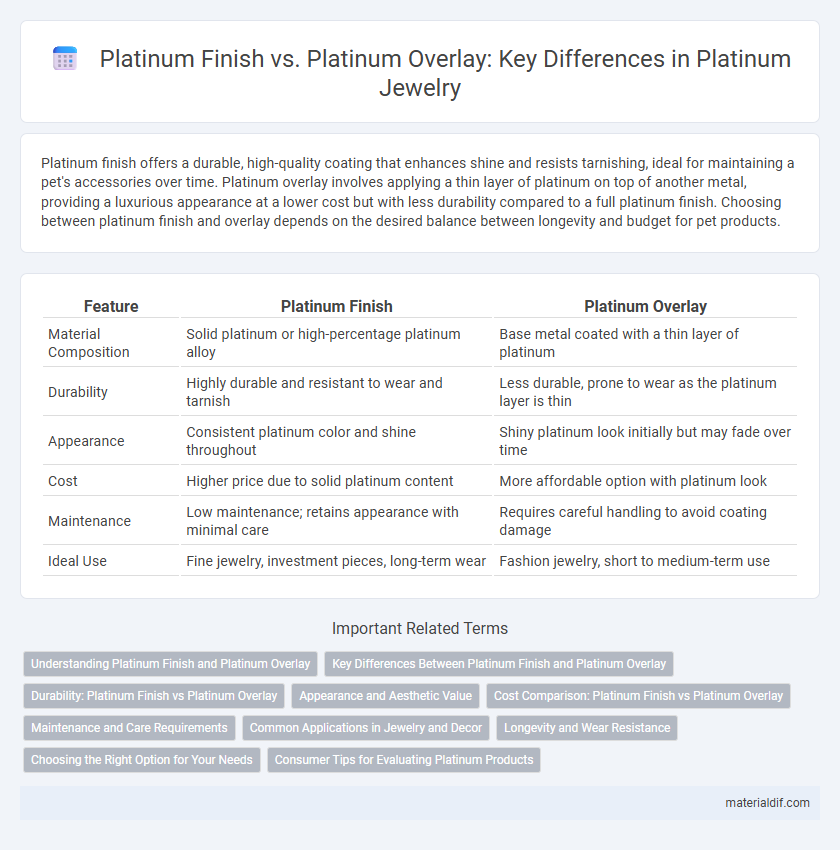Platinum finish offers a durable, high-quality coating that enhances shine and resists tarnishing, ideal for maintaining a pet's accessories over time. Platinum overlay involves applying a thin layer of platinum on top of another metal, providing a luxurious appearance at a lower cost but with less durability compared to a full platinum finish. Choosing between platinum finish and overlay depends on the desired balance between longevity and budget for pet products.
Table of Comparison
| Feature | Platinum Finish | Platinum Overlay |
|---|---|---|
| Material Composition | Solid platinum or high-percentage platinum alloy | Base metal coated with a thin layer of platinum |
| Durability | Highly durable and resistant to wear and tarnish | Less durable, prone to wear as the platinum layer is thin |
| Appearance | Consistent platinum color and shine throughout | Shiny platinum look initially but may fade over time |
| Cost | Higher price due to solid platinum content | More affordable option with platinum look |
| Maintenance | Low maintenance; retains appearance with minimal care | Requires careful handling to avoid coating damage |
| Ideal Use | Fine jewelry, investment pieces, long-term wear | Fashion jewelry, short to medium-term use |
Understanding Platinum Finish and Platinum Overlay
Platinum finish refers to a thin, pure platinum coating applied to the surface of jewelry or other items, providing a durable, corrosion-resistant, and luxurious appearance. Platinum overlay involves layering a thicker amount of platinum over a base metal, enhancing durability while maintaining an upscale look. Understanding the distinction between these two helps consumers choose based on longevity, appearance, and cost preferences in platinum jewelry.
Key Differences Between Platinum Finish and Platinum Overlay
Platinum finish refers to a solid layer of platinum applied directly to an item, offering durability and a consistent, high-quality appearance resistant to tarnishing. Platinum overlay, on the other hand, involves a thinner layer of platinum bonded over a base metal, which can be more affordable but may wear off over time with frequent use. The key difference lies in the thickness and durability of the platinum layer, with platinum finish providing long-lasting protection and platinum overlay offering cost-effective platinum aesthetics.
Durability: Platinum Finish vs Platinum Overlay
Platinum finish offers superior durability through a thicker, more resilient coating that resists tarnishing and wear better over time. In contrast, platinum overlay involves a thinner layer of platinum applied over a base metal, making it more susceptible to scratches and eventual exposure of the underlying material. The enhanced durability of platinum finish ensures longer-lasting protection and maintains jewelry's premium appearance much more effectively than platinum overlay.
Appearance and Aesthetic Value
Platinum finish offers a smooth, uniform coating that enhances the natural shine and luster of the metal, creating a sleek and modern aesthetic ideal for jewelry and luxury items. Platinum overlay involves layering a thinner layer of platinum over another metal, providing a similar visual appeal but with less durability and potential for wear over time. The platinum finish typically delivers a richer, more consistent appearance, while platinum overlay allows for cost-effective aesthetics with slightly reduced longevity.
Cost Comparison: Platinum Finish vs Platinum Overlay
A Platinum Finish typically costs less than a Platinum Overlay due to the thinner layer of platinum applied, reducing material expenses. Platinum Overlay involves depositing a thicker, more durable platinum layer, increasing both labor and material costs, resulting in a higher price point. Consumers seeking long-term wear and value often opt for Platinum Overlay despite its premium cost, while budget-conscious buyers may prefer the more affordable Platinum Finish.
Maintenance and Care Requirements
Platinum finish surfaces require regular cleaning with non-abrasive, pH-neutral products to maintain their lustrous appearance and prevent tarnishing. Platinum overlay items, with their thinner layer, demand gentler handling and less frequent polishing to avoid wearing through the precious metal. Proper storage and avoiding exposure to harsh chemicals or abrasive materials are essential for both finishes to prolong durability and preserve their brilliance.
Common Applications in Jewelry and Decor
Platinum finish enhances jewelry and decor by applying a thin, durable layer of platinum to create a luxurious, reflective surface, often used in affordable fashion pieces and decorative accents. Platinum overlay involves bonding a thicker platinum layer onto a base metal, providing greater durability and weight, typically found in high-end jewelry and premium decorative items. Both techniques offer a prestigious appearance, with platinum finish favored for cost-effectiveness and platinum overlay chosen for long-lasting quality in rings, bracelets, watches, and ornamental home decor.
Longevity and Wear Resistance
Platinum finish offers enhanced longevity through a thicker, more durable layer that resists wear and corrosion better than platinum overlay, which features a thinner coating prone to quicker fading and damage. The substantial thickness of platinum finish ensures sustained protection and maintains its luster over time, making it ideal for high-use items. In contrast, platinum overlay provides a cost-effective alternative but requires more frequent reapplication to preserve its appearance and protective qualities.
Choosing the Right Option for Your Needs
Platinum finish offers a durable and high-quality coating that enhances the metal's natural luster, making it ideal for jewelry and luxury items requiring long-lasting elegance. Platinum overlay provides a thinner layer of platinum on a base metal, offering an affordable way to achieve the look of solid platinum while reducing costs. Choosing between platinum finish and platinum overlay depends on your budget, desired durability, and whether you prioritize long-term wear or cost-effective aesthetics.
Consumer Tips for Evaluating Platinum Products
When evaluating platinum products, consumers should distinguish between a platinum finish and a platinum overlay to ensure authenticity and durability. A platinum finish typically involves a thin, surface-level coating that may wear off over time, while a platinum overlay consists of a thicker, more substantial layer that offers better resistance to tarnishing and abrasion. Prioritizing product descriptions with millesimal fineness marks (such as 950 or 900) and requesting certification or assay reports helps consumers verify the genuine platinum content and quality before purchase.
Platinum Finish vs Platinum Overlay Infographic

 materialdif.com
materialdif.com